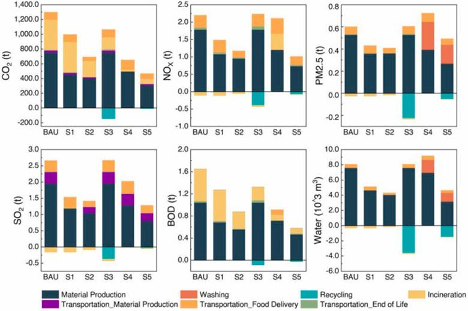Rethinking Takeaway Waste - Can Circular Packaging Cut the Footprint of Food Delivery?
By Prof Benjamin Steuer and Prof Peixiu Chen
With food delivery booming in urbanized areas in China, so is the waste — especially from food-and-beverage containers (FaBCs). A new study by researchers from HKUST and colleagues in other institutions looked at Guangzhou's Nansha District and reveals just how much packaging is involved, and how circular economy solutions could help cut the environmental cost.
Researchers sampled 131 delivery orders from 45 restaurants in one local community. They found that each order produced about 96 grams of waste, mainly from containers (65 g), cutlery (17 g), and bags (13 g). Plastics, especially polypropylene, made up nearly 75% of this waste stream.
Extrapolated to the study area these numbers suggest 437 tonnes of FaBC waste in Nansha alone, citywide this could make up 1.3% of Guangzhou’s municipal solid waste. Surprisingly, these numbers are higher than what was reported in earlier studies in other regions of China, suggesting a trend of material intensification with rising GDP.
What’s the Impact?
The study conducted a life cycle assessment (LCA) and found that, under a business-as-usual (BAU) scenario, the area’s FaBC use in the study area in 2022 resulted in: 1,300 tonnes of CO₂, 7,750 m³ of water consumption, alongside various other environmental impacts. Manufacturing was the biggest contributor to environmental impacts (58–98%), followed by waste incineration (31% of CO₂ emissions) and emissions related to transportation for material production, food delivery, and end-of-life - collectively accounting for 10.7 % of the total CO2 emissions (see Fig. 1).
Circular Solutions: LCA of five different circular scenarios
To explore alternatives, the team modeled five circular economy scenarios that draw on Chinese consumers' circular economy related preferences for FaBC use:
- Refuse – 92% of orders skip cutlery
- Reduce – delivery order volumes drop by 47%
- Recycle – 59% of packaging is segregated and recycled
- Reuse – 44% of containers are reusable
- Compound – combines all four strategies
All scenarios showed clear improvements (see Fig. 1). The compound scenario achieved the biggest gains: 65% less CO₂, 60% less water use, and 66% lower biochemical oxygen demand (BOD). However, the reuse scenario raised trade-offs, such as higher water and energy use for washing containers. These impacts can be mitigated by improving washing efficiency and logistics.

Fig 1: Emissions and water consumption from FaBC waste of the food delivery sector in the study area under circular economy scenarios. (Source: Chen et al., 2025)
Policy Recommendations
The study proposes three policy pathways:
- Expand recycling via Extended Producer Responsibility, shifting waste management costs to businesses and investing in infrastructure for collection of FaBCs for recycling.
- Enable reuse systems, backed by regulations mandating reusable FaBCs and overseeing reverse logistics and container maintenance services.
- Ban or reduce Singe Use Plastic cutlery (and ultimately FaBCs), a policy that can facilitate the emergence of circular business models and already had a successful start in cities like Hong Kong
Ultimately, delivery services may need a comprehensive overhaul. Compared to eating in, delivery is more resource intensive. Circular practice and packaging are not only possible — they are essential. A phased approach, starting with policies to reduce cutlery, more recycling and scalable reuse systems, are important steps for more sustainable food delivery. But no matter the path forward, we cannot lose sight of the urgent need to rethink the very scope and scale of food and beverage delivery systems.
Until 27. August 2025 you can access and download here the original article free of charge.
If you have questions about the article, feel free to reach out to the main authors Prof Benjamin Steuer (HKUST): bst@ust.hk and Peixiu Chen (Macau University of Science and Technology): pxchen@must.edu.mo
Reference:
Chen, P., Steuer, B., Wu, G., Dong, L., Tong, X., de Jong, M., Sauerwein, M., 2025. A life cycle assessment on food delivery packaging in Guangzhou, China: Using consumer preferences to infer viable circular economy policy pathways, Journal of Environmental Management. Volume 391, 2025, 126478